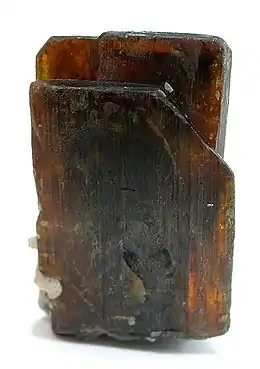Stibiotantalite
Stibiotantalite is a mineral consisting of Sb(Ta,Nb)O4 (antimony, tantalum or niobium, and oxygen). It is found in complex granite pegmatites.[2]
| Stibiotantalite | |
|---|---|
 | |
| General | |
| Category | Oxide minerals |
| Formula (repeating unit) | Sb(Ta,Nb)O4 |
| IMA symbol | Sttl[1] |
| Strunz classification | 04.DE.30 |
| Dana classification | 08.01.06.02 |
| Crystal system | orthorhombic |
| Space group | mm2 |
| Unit cell | a = 4.9, b = 11.79, c = 5.57Å, Z = 4; V = 321.78 |
| Identification | |
| Formula mass | 336.70 |
| Colour | yellow to dark brown, reddish |
| Fracture | brittle-conchoidal |
| Mohs scale hardness | 5.5 |
| Streak | light yellow |
| Diaphaneity | transparent to translucent |
| Density | 6 to 7.57 |
| Refractive index | 1.55 - 1.69 |
| Birefringence | Biaxial (+), a=2.3742, b=2.4039 |
| 2V angle | 75.083 |
| Dispersion | strong |
If the quantity of niobium exceeds the tantalum content, the mineral is called stibiocolumbite.[3]
It is translucent to transparent, medium hard (5.5 mohs), appears yellow to dark brown, reddish or greenish brown, with an adamantine luster.
Stibiotantalite is found in veins and walls associated with tin mines. It is a fairly rare to rare mineral. Due to its relative softness, it is more likely to be found in mineral collections than in jewelry.[3]
Occurrence
Stibiotantalite has been found in several countries, but the most significant are Mozambique, Sri Lanka, and the USA. It occurs in complex granite pegmatites. [4]
Mozambique and the USA have the most localities where Stibiotantalite has been found. [5] Mozambique has 6, while the USA has 18. California alone has 15 of these localities.
Use
Stibiotantalite is primarily used as a gemstone.[4] These gems are vivid, shiny, and golden-brown. These gems come between 0.73 carats and 6.34 carats, with the average being 3.54. These gems are similar in appearance to sphalerite, but they are brown instead of orange. While stibiotantalite and tantalite are similar, stibiotantalite is softer, brighter, and heavier.
Etymology
The "stibio-" prefix is a reference to its antimony content. The tantalite suffix shows that the mineral is actually very similar to tantalite. [4]
References
- Warr, L.N. (2021). "IMA–CNMNC approved mineral symbols". Mineralogical Magazine. 85 (3): 291–320. Bibcode:2021MinM...85..291W. doi:10.1180/mgm.2021.43. S2CID 235729616.
- "Stibiotantalite Mineral Data". Web Mineral. Retrieved March 9, 2019.
- "Stibiotantalite Value, Price, and Jewelry Information". International Gem Society. Retrieved March 9, 2019.
- "Stibiotantalite". Gemdat. Gemdat. Retrieved 28 September 2022.
- "Stibiotantalite". Mindat. mindat. Retrieved 28 September 2022.